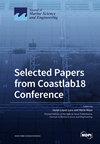三维通道中水平浮动柔性膜上的电流载荷
IF 2.8
3区 地球科学
Q1 ENGINEERING, MARINE
引用次数: 0
摘要
根据线性化小振幅波理论建立了一个三维分析模型,用于分析水平柔性膜在波流相互作用下的行为。膜与弹簧系泊装置相连以保持稳定。格林函数法用于获得频散关系,并通过速度分解法用于求解。另一方面,还简要介绍了实验情况。通过将反射系数和透射系数的结果与实验数据集进行比较,检验了分析结果的准确性。对膜的位移和垂直力的若干数值结果进行了深入研究,以检验水流载荷、弹簧刚度、膜张力、振荡模式和水深的影响。研究发现,随着流速(CS)的增加,挠度也会增加,而在深水区挠度会减小。另一方面,弹簧刚度对柔性膜振动的影响很小。当考虑垂直力时,较高的振荡模式会增加膜上的垂直载荷,对于中等波长,膜上的垂直波载荷会随着 CS 的增加而增加。此外,还介绍了相位和群速度的影响。介绍并分析了 CS 的影响以及它们在水深方面的比较。该分析通过阐明水流负荷如何影响不同水深下浮动膜的动力学,将为基于膜的波浪能转换器和防波堤的设计提供参考。本文章由计算机程序翻译,如有差异,请以英文原文为准。
Current Loads on a Horizontal Floating Flexible Membrane in a 3D Channel
A 3D analytical model is formulated based on linearised small-amplitude wave theory to analyse the behaviour of a horizontal, flexible membrane subject to wave–current interaction. The membrane is connected to spring moorings for stability. Green’s function approach is used to obtain the dispersion relation and is utilised in the solution by applying the velocity decomposition method. On the other hand, a brief description of the experiment is presented. The accuracy level of the analytical results is checked by comparing the results of reflection and the transmission coefficients against experimental data sets. Several numerical results on the displacements of the membrane and the vertical forces are studied thoroughly to examine the impact of current loads, spring stiffness, membrane tension, modes of oscillations, and water depths. It is observed that as the value of the current speed (CS) rises, the deflection also increases, whereas it declines in deeper water. On the other hand, the spring stiffness has minimal effect on the vibrations of the flexible membrane. When vertical force is considered, higher oscillation modes increase the vertical loads on the membrane, and for a mid-range wavelength, the vertical wave loads on the membrane grow as the CS increases. Further, the influence of the phase and group velocities are presented. The influences of CS and comparisons between them in terms of water depth are presented and analysed. This analysis will inform the design of membrane-based wave energy converters and breakwaters by clarifying how current loads affect the dynamics of floating membranes at various water depths.
求助全文
通过发布文献求助,成功后即可免费获取论文全文。
去求助
来源期刊

Journal of Marine Science and Engineering
Engineering-Ocean Engineering
CiteScore
4.40
自引率
20.70%
发文量
1640
审稿时长
18.09 days
期刊介绍:
Journal of Marine Science and Engineering (JMSE; ISSN 2077-1312) is an international, peer-reviewed open access journal which provides an advanced forum for studies related to marine science and engineering. It publishes reviews, research papers and communications. Our aim is to encourage scientists to publish their experimental and theoretical results in as much detail as possible. There is no restriction on the length of the papers. The full experimental details must be provided so that the results can be reproduced. Electronic files and software regarding the full details of the calculation or experimental procedure, if unable to be published in a normal way, can be deposited as supplementary electronic material.
 求助内容:
求助内容: 应助结果提醒方式:
应助结果提醒方式:


